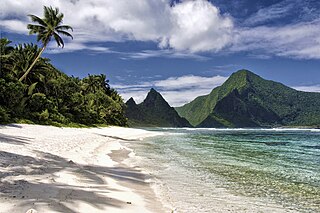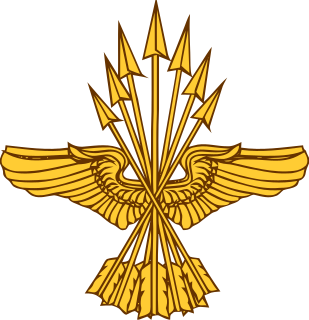
The Treaty of Paris of 1898 was a treaty signed by Spain and the United States on December 10, 1898, that ended the Spanish–American War. Under it, Spain relinquished all claim of sovereignty over and title to Cuba and also ceded Puerto Rico, Guam, and the Philippines to the United States. The cession of the Philippines involved a compensation of $20 million from the United States to Spain.
In the United States, a territory is any extent of region under the sovereign jurisdiction of the federal government of the United States, including all waters. The United States asserts sovereign rights for exploring, exploiting, conserving, and managing its territory. This extent of territory is all the area belonging to, and under the dominion of, the United States federal government for administrative and other purposes. The United States total territory includes a subset of political divisions.
An associated state is the minor partner in a formal, free relationship between a political territory with a degree of statehood and a nation, for which no other specific term, such as protectorate, is adopted.

Political divisions of the United States are the various recognized governing entities that together form the United States – states, the District of Columbia, territories and Indian reservations.

"51st state", in post-1959 American political discourse, is a phrase that refers to areas or locales that are—seriously or facetiously—considered candidates for U.S. statehood, joining the 50 states that presently compose the United States. The phrase has been applied to external territories as well as parts of existing states which would be admitted as separate states in their own right.

In the law of the United States, an insular area refers to U.S.-associated jurisdictions not part of the 50 states or the District of Columbia. This includes fourteen U.S. territories administered under U.S. sovereignty, as well as three sovereign nations each with a Compact of Free Association with the United States. The term also may be used to refer to the previous status of the Philippine Islands and the Trust Territory of the Pacific Islands when it existed.

Territories of the United States are sub-national administrative divisions overseen by the United States federal government. The various U.S. territories differ from the U.S. states and Native American tribes in that they are not sovereign entities. In contrast, each state has a sovereignty separate from that of the federal government and each federally recognized Native American tribe possesses limited tribal sovereignty as a "dependent sovereign nation". Territories are classified by incorporation and whether they have an "organized" government through an organic act passed by the Congress. U.S. territories are under U.S. sovereignty and, consequently, may be treated as part of the United States proper in some ways and not others. Unincorporated territories in particular are not considered to be integral parts of the United States, and the Constitution of the United States applies only partially in those territories.
The Insular Cases are a series of opinions by the U.S. Supreme Court in 1901, about the status of U.S. territories acquired in the Spanish–American War, and the periods shortly thereafter. When the war ended in 1898, the United States had to answer the question of whether or not people in newly acquired territories were citizens, a question the country had never faced before. The preliminary answer came from a series of Supreme Court rulings, now known as the Insular Cases, which responded to the question of how American constitutional rights apply to those in United States territories. The Supreme Court held that full constitutional protection of rights does not automatically extend to all places under American control. This meant that inhabitants of unincorporated territories such as Puerto Rico—"even if they are U.S. citizens"—may lack some constitutional rights. Today, many legal scholars refer to the Insular Cases as a constitutional justification for colonialism and annexation of places not within United States boundaries. The Insular Cases "authorized the colonial regime created by Congress, which allowed the United States to continue its administration—and exploitation—of the territories acquired from Spain after the Spanish–American War." These Supreme Court rulings allowed for the United States government to extend unilateral power over these newly acquired territories.
Commonwealth is a term used by two unincorporated territories of the United States in their full official names, which are the Northern Mariana Islands, whose full name is Commonwealth of the Northern Mariana Islands, and Puerto Rico, which is named Commonwealth of Puerto Rico in English and Estado Libre Asociado de Puerto Rico in Spanish, translating to "Free Associated State of Puerto Rico." The term was also used by the Philippines during most of its period under U.S. sovereignty, when it was officially called the Commonwealth of the Philippines.

The Office of Insular Affairs (OIA) is a unit of the United States Department of the Interior that oversees federal administration of several United States insular areas. It is the successor to the Bureau of Insular Affairs of the War Department, which administered certain territories from 1902 to 1939, and the Office of Territorial Affairs in the Interior Department, which was responsible for certain territories from the 1930s to the 1990s. The word "insular" comes from the Latin word insula ("island").
In the United States, each state has its own written constitution.
Balzac v. Porto Rico, 258 U.S. 298 (1922), was a case in which the Supreme Court of the United States held that certain provisions of the U.S. Constitution did not apply to territories not incorporated into the union. It originated when Jesús M. Balzac was prosecuted for criminal libel in a district court of Puerto Rico. Balzac declared that his rights had been violated under the Sixth Amendment to the U.S. Constitution as he was denied a trial by jury since the code of criminal procedure of Puerto Rico did not grant a jury trial in misdemeanor cases. In the appeal, the U.S. Supreme Court affirmed the judgments of the lower courts on the island in deciding that the provisions of the Constitution did not apply to a territory that belonged to the United States but was not incorporated into the Union. It has become known as one of the "Insular Cases".
Federal tribunals in the United States are those tribunals established by the federal government of the United States for the purpose of resolving disputes involving or arising under federal laws, including questions about the constitutionality of such laws. Such tribunals include both Article III tribunals as well as adjudicative entities which are classified as Article I or Article IV tribunals. Some of the latter entities are also formally denominated as courts, but they do not enjoy certain protections afforded to Article III courts. These tribunals are described in reference to the article of the United States Constitution from which the tribunal's authority stems. The use of the term "tribunal" in this context as a blanket term to encompass both courts and other adjudicative entities comes from section 8 of Article I of the Constitution, which expressly grants Congress the power to constitute tribunals inferior to the Supreme Court of the United States.
The United States territorial courts are tribunals established in territories of the United States by the United States Congress, pursuant to its power under Article Four of the United States Constitution, the Territorial Clause. Most United States territorial courts are defunct because the territories under their jurisdiction have become states or been retroceded.

The Bureau of Insular Affairs was a division of the United States Department of War that oversaw civil aspects of the administration of several territories from 1898 until 1939.

The Insular Government of the Philippine Islands, was an unincorporated territory of the United States that was established in 1901 and was dissolved in 1935. The Insular Government was preceded by the United States Military Government of the Philippine Islands and was followed by the Commonwealth of the Philippines.

The political status of Puerto Rico is that of an unincorporated territory of the United States. As such, the island of Puerto Rico is neither a sovereign nation nor a U.S. state. Because of that ambiguity, the territory, as a polity, lacks certain rights but enjoys certain benefits that other polities have or lack. For instance, in contrast to U.S. states, Puerto Rico residents cannot vote in U.S. presidential elections nor can they elect their own senators and representatives to the U.S. Congress. On the other hand, in contrast to U.S. states, only some residents of Puerto Rico are subject to federal income taxes. The political status of the island thus stems from how different Puerto Rico is politically from sovereign nations and from U.S. states.
Voting rights of citizens in Guam differ from those of United States citizens in each of the fifty states. In the U.S. House of Representatives, Guam is entitled to a delegate, who is not allowed to vote on the floor of the House, but can vote on procedural matters and in House committees. Citizens of Guam may not vote in general elections for President.









